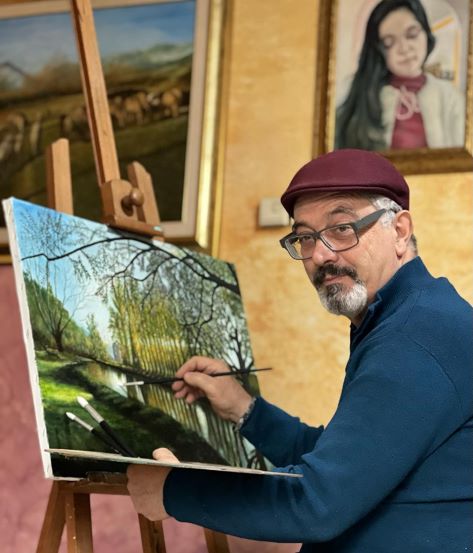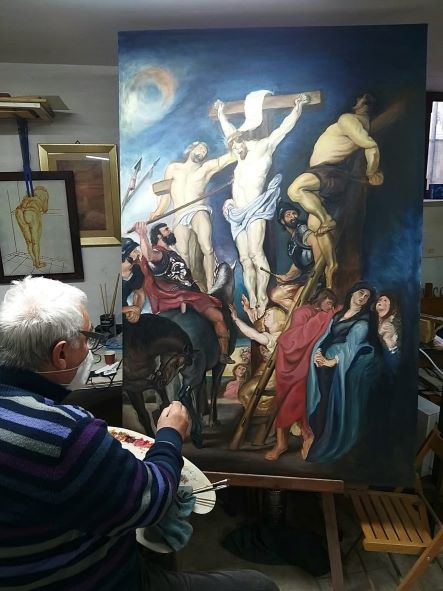
Antonio Presutti.
Antonio Presutti was born in 1957 in Telese Terme (Bn). Like the artists of the past, from an early age he showed a particular inclination for the world of painting and so, at the age of six, he began to frequent the studio of his brother Stefano (painter and sculptor) who was twelve years older than him. He is confronted for the first time with the rudiments of art, with pencil drawings in charcoal and sanguine, with drawing from life and with the study of perspective. Under the guidance of his brother, he continued to deepen the drawing over the years, focusing his interest on the human figure and at the same time consolidating his knowledge of the techniques. He acquires practical knowledge on the preparation of the canvases, on the mixing of colors, on the use of the spatula and solvents. In 1962 he met Valente Assenza, an esteemed Sicilian painter who was the master of his brother. The illustrious painter, brother of the more well-known Beppe and Enzo artists, of whom the first winner of two Venice Biennials, observing the child's drawings, is struck by the spontaneous and clean talent that, later on, he will define lacking in any academic contamination and urges him to continue along this path by expressing the desire to see him among the students of the life drawing school of the Cerretese Art Institute where he taught in those years. Antonio, now grown up, will not follow the suggested path nevertheless he never abandons his goal, on the contrary he confronts himself with the Renaissance masters, capturing through the study of their drawings, significant details that will help him improve his pictorial knowledge. At the age of twelve, he entered his brother's atelier and, taking advantage of his absence, stole some colors and began to paint a copy depicting the Virgin, the child and Saint Anne by Leonardo da Vinci. Expecting that the painter could have noticed the wrongdoing, he hides the picture in an adjacent room but is discovered by his mother and the news reaches his brother. He does not imagine that the two were impressed by the skill with which he made the copy. He will understand this when he notices that his brother, instead of being angry, encourages him to continue painting by giving him a pack of colors. That gift is a gesture of admiration for a talent that still needs to push his boundaries; Antonio knows this well but what fascinates him most is the painting that transmits strong sensations in which the contrasts of light blend with the mystery of a troubled historical era; the painting of a seventeenth-century artist: Caravaggio. Some sanguine copies date back to 1976 including the detail of Christ taken from the "Conversion of St. Matthew" and the figure of the pilgrim who spreads his arms in the "Supper of Emmaus" and subsequently the copy of the "Fruit basket". But painting must necessarily acquire a much deeper meaning for the young artist. In this long research Antonio begins to weigh his moods, tries to filter the sensations and emotions are analyzed, decoded. thus the contents are enriched with a new, more complete value. Already in 1982 he created what will perhaps be one of the most representative paintings of his future production entitled: the Will and the act. The idea for the composition comes from both brothers (there are, in this sense, two versions, the company could be considered the only one in the history of contemporary painting). In it, the authors, reconciling the allegorical meaning, bring to light the different aspects and the different aspirations towards which human nature tends.
On the proposal of his brother he participated in his first extemporaneous exhibition in 1976, receiving the applause of the jury and wide critical consensus. He will remain on the public scene until 1982, participating in other important national events; his works always arouse full consent not only from critics but also from the public and that's what matters most to him. It is only ten years of experience that allow him to understand which path to choose. He does not need other statements, he just needs to remember the words that Maestro Assenza had said to his brother, one of his favorite disciples: the boy has an innate talent, make sure that he continues, he stays close to him. In 1980 Antonio was in the artist's atelier in Monte Mario in the company of Stefano, he has recently completed a portrait of a child which he submits to the Master's vision. The then sixty-six year old painter (1914-1998) after placing the painting on the easel examines the work carefully observing it then exclaims: the portrait is perfect but one thing is missing! He goes to the palette dips the brush in the color and gives two touches of light in the eyes of the child. Antonio immediately realizes that that non-verbal message represents the light of life, he will understand it well when, about twenty years later, he will read the two books that the old Master had advised him back in 1976: "how do you look at a painting" and " knowing how to see ". Antonio, in his production, will implement the teachings of his precursors and will try to see in a different and deeper light (the light of the soul) what nature exalts through the mysteries of life.
Antonio Presutti was born and trained, in an artistic sense, in the atelier of his brother Stefano, already an established painter in the late sixties. In that shop, amidst the pungent smells of turpentine, oils and solvents, the child gazes spellbound at the canvases and rural scenes that have been commissioned to his brother. He is so enraptured by the beauty of those colors and characters that animate those representations that he very often leaves out the game to devote himself to the contemplation of the paintings while the Master is grappling with the work.
He observes without speaking, memorizing the various phases; from the mixing of colors to the preparation of the canvases, from the use of the palette knife to the study of anatomy for the drawing of the human figure. He learns the basics of drawing from life; as the shadows are distributed and diversified, he begins to understand the difference between looking and seeing.
These teachings combined with his technique will later serve him to refine his stylistic skills.
Together with his brother, he made his public debut for the first time in 1973, winning his first silver medal. The acclaim of the critics arrived and with them the encouragement of the illustrious painter Valente Assenza, Sicilian by birth and Roman by adoption who in those years was at the helm of the Cerreto school and teacher of his brother Stefano.
On more than one occasion, the artist will enhance the boy's innate talent and urge him to continue following the example and suggestions of his disciple. Other statements will later strengthen this belief. Antonio will continue to work away from the public arena. He will then turn his attention to that classical painting that best suits his expressive abilities, combining aesthetic research with philosophical introspection. In every painting of him you can see a reference to the reality of the historical moment, through metaphorical or allegorical games.
In 2008 he participated in a contemporary art collective at the O.A.D. of Rome with the painting entitled: "The will and the act". He participated in the Principality of Luxembourg Art Prize in 2019. He is among the one hundred finalists of the “Vittorio Sgarbi 2021 Award”.
He continues to frequent his brother's atelier today and to follow his precious advice.
" My artistic fortune began in my family, as the brother of the art teacher Stefano, 12 years older than me. Thanks to him who attended the school of Cerreto (BN) directed by Valente Assenza in the 60s,brother of the more well-known Beppe Assenza of the Anthroposophical school of Dornach founded by Rudolf Steiner, I learned by attending his first workshop since I was a child learning on drawing, painting and ceramics. I trained artistically in his atelier following the phases of didactic growth through the acquisition of various tecniques starting from the preparation of the canvases to get to the mixing of colors, just as the artist once did. I followed closely his career sometimes even posing for him and I collaboreted on some of his works and on the restoration of wooden statues. This sort of apprendiceship began already in the late 60s, in this period the same Valente Assenza extolled my talent urging me to continue and it’s what I did for fifty years until now, continuing constantly to follow the teachings of my teacher and mentor.I received various awards and won many premiums since the age of 16.Today some of my paintings are in privatecollections or adorn salons of admirers. Today I am a member, along with other emerging artists, of an art school: Samnium l’Essenza dell’Arte”, located in Telese Terme (BN). "
Antonio Presutti
List of participation in artistic competitions:
1976 National Competition Award for extemporaneous painting Sant’Agata dei Goti (BN)
1978 Collective Art City of the Maddaloni Boys (CE)
1979 Historical Association Award of the Medio Volturno (CE)
1981 Historical Association Award of the Medio Volturno (CE)
1982 Collective Art of the City of Pontelandolfo (BN)
2008 Collective of Modern Art at AOD Rome
2014 Flavors and colors in the art of Sannio BacArt Guardia Sanframondi Award (BN)
2019 Present at the Luxemburg Art Prize
2021 Among the 100 finalists of the Vittorio Sgarbi Prize with an exhibition of the work at the Salone delle Fiere in Ferrara
2022 Present at the Luxemburg Art Prize
Inserted in the yearbooks of the Historical Association of the Middle Voltuno for the years 1979 and 1981
They wrote about him: D. Loffreda, D. Marrocco, R.Perrotti and others.
SEE ALL ARTWORKS BY ANTONIO PRESUTTI

